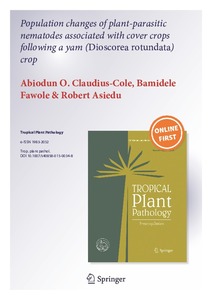| dc.contributor.author | Claudius-Cole, A.O. |
| dc.contributor.author | Fawole, B. |
| dc.contributor.author | Asiedu, Robert |
| dc.date.accessioned | 2019-12-04T10:58:04Z |
| dc.date.available | 2019-12-04T10:58:04Z |
| dc.date.issued | 2015 |
| dc.identifier.citation | Claudius-Cole, A.O., Fawole, B., & Asiedu, R. (2015). Population changes of plant-parasitic nematodes associated with cover crops following a yam (Dioscorea rotundata) crop. Tropical Plant Pathology, 40(3), 193-199. |
| dc.identifier.issn | 1983-2052 |
| dc.identifier.uri | https://hdl.handle.net/20.500.12478/907 |
| dc.description | Published online: 11 July 2015 Online ISSN in use. |
| dc.description.abstract | Effective management of plant-parasitic nematodes
affecting yams includes practices that can break the pest cycle
from field to store. This study evaluated nematode population
changes under cover crop cultivation following a main yam
crop. Ten cover crops were planted after the harvest of the yam
crop, in six different yam plots under natural nematode infes-
tation. Soil and root samples were collected quarterly for nem-
atode analysis from planting time for 12 months. Nematode
data obtained were used to calculate prominence values as
well as frequencies of occurrence for the nematode species
identified. Statistical analyses was by ANOVA and Newman
Keuls.
Helicotylenchus
spp. were the most frequently encoun-
tered and prominent nematodes followed by
Pratylenchus
spp. and
Scutellonema
spp., while
Meloidogyne
spp. ranked
sixth in prominence. The most effective cover crops were
Ta ge te s e re ct a
,
Aeschynomene histrix
,
Mucuna pruriens
and
Pueraria phaseoloides
which reduced populations of the four
aforementioned nematodes by 70, 39, 20, and 11 %, respec-
tively.
Lablab purpureus
and
Cajanus cajan
hosted signifi-
cantly higher nematode populations in their roots and rhizo-
sphere soil samples than other cover crops. Populations of
Meloidogyne
were reduced with
A. histrix, T. erecta,
Crotalaria ochroleuca, Crotalaria juncea, P. phaseoloides,
and
M. pruriens
.However,populationsof
Scutellonema
and Pratylenchus
were reduced with
A. histrix, T. erecta, P.
phaseoloides
,and
M. pruriens |
| dc.language.iso | en |
| dc.subject | Aeschynomene |
| dc.subject | Dioscorea |
| dc.subject | Meloidogyne |
| dc.subject | Tagetes |
| dc.subject | Crop Rotation |
| dc.title | Population changes of plant-parasitic nematodes associated with cover crops following a yam (Dioscorea rotundata) crop |
| dc.type | Journal Article |
| dc.description.version | Peer Review |
| cg.contributor.crp | Roots, Tubers and Bananas |
| cg.contributor.affiliation | University of Ibadan |
| cg.contributor.affiliation | International Institute of Tropical Agriculture |
| cg.coverage.region | Africa South Of Sahara |
| cg.isijournal | ISI Journal |
| cg.authorship.types | CGIAR and developing countries institute |
| cg.iitasubject | Yam |
| cg.journal | Tropical Plant Pathology |
| cg.howpublished | Formally Published |
| cg.accessibilitystatus | Limited Access |
| local.dspaceid | 76406 |
| cg.identifier.doi | https://dx.doi.org/10.1007/s40858-015-0034-8 |

